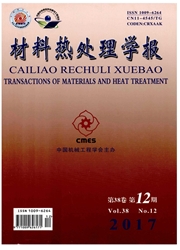

 中文摘要:
中文摘要:
采用Sn-2.5Ag-2.0Ni焊料钎焊两种化学镀Ni(P)后的SiCp/Al复合材料。由于P含量的不同,SnAgNi焊料与Ni(P)镀层之间生成了两种不同的微观结构。SnAgNi/Ni(5%P)接头中致密的Ni3Sn4金属间化合物(IMC)层导致了较低的Ni扩散速度和Ni3Sn4生长速度。而SnAgNi/Ni(10%P)焊料接头中疏松的Ni3Sn4化合物使Ni具有较高的扩散速度,从而导致较高的Ni3Sn4生长速度,这也影响了接头的剪切强度。前者的断裂主要是由Ni3Sn4化合物的生长和微裂纹的生成造成的,而后者主要是Ni向焊料中扩散使得基体和镀层之间形成了孔洞,从而导致SiCp/Al复合材料与Ni(P)镀层结合力的迅速降低。
 英文摘要:
英文摘要:
Sn-2.5Ag-2.0Ni solder was used to solder SiCp/Al composite substrate with two types of electroless Ni(P) layers.Owning to the difference in P content,there exist two possible microstructure at the interface between SnAgNi solder and Ni(P) layer.In SnAgNi/Ni(5%P) solder joint,the compact Ni3Sn4 intermetallic compound(IMC) layer leads to relatively low diffusion rate of Ni into solder and low growth rate of Ni3Sn4.While in SnAgNi/Ni(10%P) solder joint,the channels in the loose Ni3Sn4 IMCs lead to higher diffusion rate of Ni into solder, the growth rate of Ni3 Sn4 is high, and voids form between Ni(P) layer and SiC0/Al composite. Growth of intermetallic compound layer and formation of crack are responsible for failure of the SnAgNi/Ni (5 % P) solder joint. While the failure of SnAgNi/Ni (10% P) solder joint is caused by the poor adhesion between Ni(P) layer and SiC/Al composite, which resuhs from directional diffusion of Ni toward solder.
 同期刊论文项目
同期刊论文项目
 同项目期刊论文
同项目期刊论文
 Preparation, crystallization, and wetting of ZnO-Al2O3-B2O3-SiO2 glass-ceramics for sealing to Kovar
Preparation, crystallization, and wetting of ZnO-Al2O3-B2O3-SiO2 glass-ceramics for sealing to Kovar Interfacial reactions between Sn-2.5Ag-2.0Ni solder and electroless Ni(P) deposited on SiCp/Al compo
Interfacial reactions between Sn-2.5Ag-2.0Ni solder and electroless Ni(P) deposited on SiCp/Al compo Fabrication and thermal conductivity of near-net-shaped diamond/copper composites by pressureless in
Fabrication and thermal conductivity of near-net-shaped diamond/copper composites by pressureless in Effect of various Ni plating layers and aging on microstructure and shear strength of Sn-2.5Ag-2.0Ni
Effect of various Ni plating layers and aging on microstructure and shear strength of Sn-2.5Ag-2.0Ni Effect of phosphorus content on microstructure and shear strength of Sn-2.5Ag-2.0Ni/Ni(P) solder joi
Effect of phosphorus content on microstructure and shear strength of Sn-2.5Ag-2.0Ni/Ni(P) solder joi Preparation, crystallization, and wetting of ZnO-Al2O3-B2O3-SiO2 glass-ceramics for sealing to Kovar
Preparation, crystallization, and wetting of ZnO-Al2O3-B2O3-SiO2 glass-ceramics for sealing to Kovar 期刊信息
期刊信息
